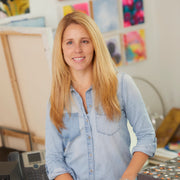While a few reflections are an advantage to show off ArtResin's shine, its high gloss finish can sometimes cause challenging reflections and hotspots. With a few simple and effective techniques for proper lighting and camera positioning, you can capture shots of your artwork like a pro:
How to photograph paintings without glare?
- Work in a controlled environment ( close curtains, turn off room lights )
- Set up 2 bright lights on either side of your artwork at 45 degree angles
- Set up your artwork so that it's at a perfectly parallel angle to your camera lens
- Take a few test shots and adjust your lights and artwork to eliminate reflections
- Once you're happy with what you see, you're ready to shoot!
Great shots of your artwork is an important marketing tool for any artist. Photographer Geoff George shares his techniques for proper lighting and camera positioning so that you can capture shots of your artwork like a pro! With Geoff's simple, inexpensive and effective set up, you'll never have to settle for shots with too much glare again.
1. Work in a controlled environment
Taking a shot with both studio lights and ambient lighting ( daylight or from lamps/ceiling lights ) can cause glare and uneven lighting. Close curtains and blinds and adjust room lights as necessary in order to control all the light hitting your piece.
2. Set up your lighting
Set up your lighting to get an equal, even wash of light, set up two identical lights on either side of your artwork at 45 degree angles. Use the brightest lights you can and ensure both lights are the same in order to provide even amounts and even colour. Never use your camera's flash or light your work from the same angle as the camera or else you'll end up with a hot spots in your work.
3. Set up your artwork
Whether you hang your artwork, lean it on a wall, or lay it on the floor, it's important that the camera is positioned at a perfectly parallel angle and that the lens is centred to the middle to avoid making your piece look distorted. Using a tripod locks the camera in and offers the most control.
4. Adjust your lights and your artwork for reflections
Examine the way your artwork looks through the lens, identifying any unwanted sources of light and finding a way to minimize them. You may need to adjust the positioning of your lights or adjust your artwork.
5. Take a few test shots
Once you're happy with what you see, you're ready to shoot!
6. Work in a controlled environment
Taking a shot with both studio lights and ambient lighting ( daylight or from lamps/ceiling lights ) can cause glare and uneven lighting. Close curtains and blinds and adjust room lights as necessary in order to control all the light hitting your piece.
7. Set up your lighting
Set up your lighting to get an equal, even wash of light, set up two identical lights on either side of your artwork at 45 degree angles. Use the brightest lights you can and ensure both lights are the same in order to provide even amounts and even colour. Never use your camera's flash or light your work from the same angle as the camera or else you'll end up with a hot spots in your work.
8. Set up your artwork
Whether you hang your artwork, lean it on a wall, or lay it on the floor, it's important that the camera is positioned at a perfectly parallel angle and that the lens is centred to the middle to avoid making your piece look distorted. Using a tripod locks the camera in and offers the most control.
9. Adjust your lights and your artwork for reflections
Examine the way your artwork looks through the lens, identifying any unwanted sources of light and finding a way to minimize them. You may need to adjust the positioning of your lights or adjust your artwork.
10. Take a few test shots
Once you're happy with what you see, you're ready to shoot!
Check out our blog on How can you be sure that ArtResin won’t Ruin your Artwork.
